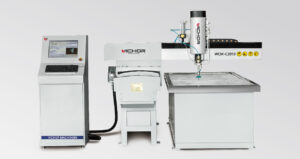
7 Key Insights into Water Jet Machining Pressure for Superior Results
Imagine a tool so precise that it can slice through titanium with the finesse of a surgeon’s scalpel, yet powerful enough to shape granite effortlessly. This isn’t science fiction—it’s the reality of water jet machining, a process where water jet machining pressure plays the starring role. In modern manufacturing, understanding the nuances of pressure in water jet systems isn’t just technical jargon; it’s the difference between flawless cuts and costly errors. Whether you’re in aerospace, automotive, or custom fabrication, grasping how pressure influences every aspect of this technology can revolutionize your workflow. In this article, we’ll dive deep into the world of water jet machining pressure, uncovering seven essential aspects that drive efficiency, quality, and innovation. From its fundamental principles to practical applications, you’ll discover why mastering this element is critical for achieving optimal outcomes in any project.
What Is Water Jet Machining Pressure and Why Does It Matter?
At its core, water jet machining involves using a high-velocity stream of water—often mixed with abrasive materials—to cut or shape various substances. The water jet machining pressure refers to the force exerted by this stream, typically measured in pounds per square inch (PSI) or megapascals (MPa). This pressure is generated by intensifier pumps or direct drive systems, which amplify water pressure to extreme levels, sometimes exceeding 60,000 PSI. But why does this matter? Simply put, water jet machining pressure is the engine behind the entire process. It determines the kinetic energy transferred to the water jet, enabling it to penetrate hard materials like metals, ceramics, and composites. Without sufficient pressure, the jet would lack the cutting power needed for precise work, leading to incomplete cuts or excessive wear on equipment. Moreover, pressure control allows for adaptability across different materials, making water jet machining a versatile solution in industries ranging from art to heavy machinery. By optimizing water jet machining pressure, operators can achieve cleaner edges, reduce material waste, and extend the lifespan of their machinery, ultimately boosting productivity and cost-effectiveness.
How Water Jet Machining Pressure Affects Cutting Precision and Quality
When it comes to achieving razor-sharp cuts, the role of water jet machining pressure cannot be overstated. Higher pressure levels generally translate to improved cutting precision, as the water stream maintains its focus and velocity over longer distances. For instance, in applications requiring intricate designs or tight tolerances—such as in medical device manufacturing—maintaining consistent water jet machining pressure ensures that the jet doesn’t diverge or lose energy, resulting in smooth, burr-free edges. Conversely, low pressure can cause kerf widening (the width of the cut), leading to inaccuracies and rough surfaces. However, it’s not just about cranking up the pressure; balance is key. Excessive water jet machining pressure might accelerate nozzle wear or induce micro-cracks in brittle materials like glass. Therefore, operators must calibrate pressure based on material thickness and hardness. For example, cutting a 2-inch steel plate might require pressures around 55,000 PSI, while softer materials like foam could need as little as 30,000 PSI. By fine-tuning water jet machining pressure, manufacturers can minimize secondary finishing processes, saving time and resources while delivering superior quality products.
The Relationship Between Pressure and Material Compatibility
One of the standout features of water jet machining is its ability to handle a wide array of materials, and water jet machining pressure is the linchpin in this versatility. Different materials respond uniquely to pressure variations, making it crucial to match the pressure settings to the substance being worked on. For dense, hard materials like tungsten or hardened steel, high water jet machining pressure—often above 50,000 PSI—is necessary to overcome their tensile strength and achieve clean cuts. On the other hand, softer materials like rubber or wood require lower pressures to prevent over-penetration or deformation. This adaptability stems from the physics of the water jet: as pressure increases, the stream’s velocity rises, enhancing its cutting ability without generating heat (a key advantage over laser or plasma cutting). Additionally, the use of abrasives in conjunction with water jet machining pressure expands compatibility to include composites and heat-sensitive materials, which could warp under thermal stress. By understanding this relationship, operators can prevent material damage, reduce waste, and ensure consistent results across diverse projects, from architectural stonework to aerospace components.
Optimizing Water Jet Machining Pressure for Efficiency and Cost Savings
In any manufacturing process, efficiency and cost control are paramount, and water jet machining pressure plays a direct role in both. Optimizing pressure isn’t just about achieving the best cut; it’s about doing so in a way that maximizes resource utilization. For instance, running a system at excessively high water jet machining pressure can lead to increased energy consumption and faster component degradation, such as pump seals and nozzles, driving up maintenance costs. Conversely, underutilizing pressure might prolong cutting times, reducing throughput and raising labor expenses. To strike the right balance, operators often use pressure modulation techniques, such as variable pressure settings that adjust in real-time based on material feedback. This approach minimizes energy use while maintaining cutting speed and quality. Moreover, proper water jet machining pressure calibration can extend the life of abrasive materials—a significant cost factor—by ensuring they are used efficiently. For example, in high-pressure scenarios, less abrasive may be needed to achieve the same cut, lowering material costs. By implementing best practices in pressure management, businesses can achieve up to 20% savings in operational expenses, making water jet machining a more sustainable and profitable choice.
Safety Considerations in High-Pressure Water Jet Systems
Working with water jet machining pressure that exceeds 50,000 PSI introduces significant safety risks that cannot be ignored. The immense force involved can cause severe injuries or equipment failure if not properly managed. Key hazards include hose ruptures, nozzle blowouts, and high-velocity debris, all of which underscore the need for robust safety protocols. For example, systems should be equipped with pressure relief valves and emergency shut-offs to prevent over-pressurization. Regular inspections of components like intensifier pumps and fittings are essential to detect wear before it leads to accidents. Additionally, operator training on water jet machining pressure controls is critical; understanding how to gradually ramp up pressure or respond to fluctuations can prevent mishaps. Personal protective equipment (PPE), such as safety glasses and reinforced gloves, is mandatory to shield against potential jets or splashes. By prioritizing safety in high-pressure environments, companies not only protect their workforce but also ensure uninterrupted operations, as accidents can result in costly downtime and repairs. Remember, a well-maintained system with controlled water jet machining pressure is a safe one.

The Impact of Pressure on Nozzle and Equipment Longevity
The durability of water jet machining equipment is closely tied to how water jet machining pressure is applied. Nozzles, in particular, bear the brunt of high-pressure streams, and their lifespan can vary dramatically based on pressure settings. At elevated pressures, nozzles experience accelerated erosion from abrasive particles, leading to frequent replacements and increased downtime. For instance, a nozzle operating at 60,000 PSI might last only 100 hours, whereas at 40,000 PSI, it could endure 200 hours or more. Similarly, pumps and seals are susceptible to stress under high water jet machining pressure, requiring regular maintenance to avoid failures. To mitigate this, operators can adopt pressure-reducing strategies, such as using larger orifice nozzles for lower-pressure applications or implementing soft-start features that gradually increase pressure. Monitoring water jet machining pressure through sensors and automated systems also helps in early detection of anomalies, preventing catastrophic equipment damage. By aligning pressure with operational needs, businesses can extend the service life of their machinery, reduce replacement costs, and maintain consistent performance over time.
Future Trends in Water Jet Machining Pressure Technology
As technology evolves, so does the realm of water jet machining pressure. Innovations are pushing the boundaries of what’s possible, with trends focusing on smarter pressure control and sustainability. For example, the integration of IoT (Internet of Things) and AI allows for real-time adjustments to water jet machining pressure based on material sensors, optimizing cuts without human intervention. This not only enhances precision but also reduces energy waste. Additionally, developments in pump technology aim to achieve higher pressures—up to 100,000 PSI—while improving efficiency, enabling faster cutting speeds and broader material capabilities. Another emerging trend is the use of eco-friendly practices, such as recycling water and abrasives in high-pressure systems, which aligns with global sustainability goals. By staying abreast of these advancements, manufacturers can leverage water jet machining pressure to gain a competitive edge, whether through reduced environmental impact or enhanced automation. The future promises even greater control over pressure parameters, making water jet machining an indispensable tool in next-generation manufacturing.
In summary, water jet machining pressure is the heartbeat of this innovative technology, influencing everything from cut quality and material handling to cost and safety. By mastering its aspects—from fundamental principles to advanced optimizations—operators can unlock new levels of performance and reliability. As industries continue to demand precision and versatility, a deep understanding of water jet machining pressure will remain essential for success.
Frequently Asked Questions About Water Jet Machining Pressure
Q1: What is the typical range of water jet machining pressure used in industrial applications?
A1: The typical range for water jet machining pressure in industrial settings varies from 30,000 to 90,000 PSI, with most applications falling between 50,000 and 60,000 PSI. This range allows for efficient cutting of diverse materials, from soft plastics to hardened metals, while balancing energy consumption and equipment wear.
Q2: How does water jet machining pressure influence cutting speed?
A2: Water jet machining pressure directly affects cutting speed; higher pressure generally increases speed by providing more kinetic energy to the water stream. For example, doubling the pressure can reduce cutting time for thick materials by up to 30%, but it must be optimized to avoid compromising cut quality or accelerating nozzle erosion.
Q3: Can high water jet machining pressure damage sensitive materials?
A3: Yes, excessively high water jet machining pressure can cause damage to sensitive materials like brittle ceramics or thin composites by inducing cracks or delamination. It’s crucial to adjust pressure settings based on material properties and use lower pressures or specialized nozzles for delicate applications.
Q4: What factors should be considered when selecting the right water jet machining pressure for a project?
A4: When selecting water jet machining pressure, consider material type, thickness, desired cut quality, and equipment capabilities. Thicker, harder materials require higher pressure, while thinner or softer ones need lower settings to prevent over-cutting. Consulting pressure charts and conducting test cuts can help determine the optimal level.
Q5: How often should water jet machining pressure systems be maintained to ensure performance?
A5: Maintenance frequency depends on usage, but generally, water jet machining pressure systems should be inspected every 200-500 hours of operation. Key checks include nozzle wear, pump seals, and pressure calibration to prevent failures and maintain consistent performance, especially in high-pressure environments.
continue reading
Related Posts
- 1352 words6.8 min read
- 1378 words6.9 min read


